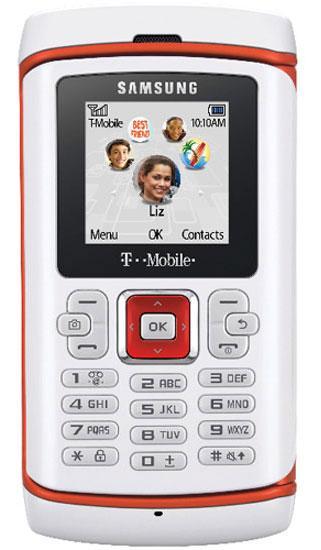With the wireless market becoming increasingly saturated, manufacturers are relying more and more on unique designs to appeal to buyers. While it's inevitably going to be a love or hate design, the Samsung Comeback is unique, and is a welcome addition to the T-Mobile lineup. Will its quirky design and features impress, or is it just another phone in the lineup?
Sporting an increasingly popular form factor found in its competitors, the Samsung Comeback offers a full QWERTY keyboard in a flip-like design. Coming in at 4.33 inches long by 2.2 inches wide by 0.73 inch thick, the Comeback weighs 4.6 ounces, so it's on the lighter side. Externally, the Comeback offers a 1-inch display with 65,000 colors. It's small, and can be challenging when it comes to viewing text, but it gets the job done. Open the device up to reveal the true gem, a 2.7-inch internal display that offers 262,000 colors and a 240 x 400 pixel resolution. When using it, images were crisp and clear. The primary thing that perplexed us was the somewhat strange design. Instead of separating completely (like the enV Touch), only a part of the device flips open, leaving two raised edges. Additionally, the Comeback's corners make it a bit bulky, and through the hinge seems to be quite durable, the white plastic gives it the impression of being cheap.
The left side of the Comeback offers a volume rocker and a charging port that doubles as a headphone input port (adapter needed). The front of the device houses a D-pad with a numeric keypad and five buttons: two shortcut keys, and talk, back, end, and camera keys. The camera lens and external speaker can be found on the back, and the microSD card slot is located under the battery. Like others in the category, packaging is minimal. Besides the Comeback and a battery, a home charger, hands-free headset, and instruction manuals are included.

Like most of the other wireless carriers, T-Mobile is moving to a unified user interface, which can be found on the Comeback. We found it relatively easy to navigate, with six main menus: People, Messaging, Media, Settings, Organizer, and Call History. The device offers a full HTML browser with support for Javascript and Flash Lite, and e-mail support for AIM Mail, AOL, Yahoo, Comcast, CS, Juno, Verizon, and Gmail. While you are able to input addresses that aren't part of T-Mobile's official list, there's no place to put your mail server, so non-supported e-mail accounts may not properly send or receive mail. Additionally, the Comeback is quite the media junkie, supporting popular mediums like MP3, WMA, AAC/AAC+, and MPEG4 audio formats.
The interior layout consists of a QWERTY keyboard with a dedicated URL entry key and emoticon key, coupled with a secondary D-pad with messaging, camera, send, end, and clear keys. Two shortcut keys can be found on the hinge of the device. Overall, the keyboard was less than impressive. While the keys are reasonably tall, they're too narrow, and are way too close together. What's more, the raised edges that were discussed earlier make the keyboard appear to be "recessed," making it challenging to type accurately. People with large hands will have trouble using the keyboard on a regular basis. On a positive note, no lag is present whatsoever, so those used to typing quickly can do so on the device. With the Comeback offering an external numeric keypad as a secondary input option, it's nice to have the ability to accomplish small tasks using it, and when the time comes to compose a long message, to open up the device and start typing.
The Samsung Comeback offers a 2.0 megapixel camera, and though the pictures themselves weren't that impressive, the numerous customization options are. The device provides a number of features, including four resolutions, various shooting modes, five white balance settings, numerous color effects, a self-timer, shutter tones, and two preview modes, among other nifty features. While providing similar features including the option to chop for MMS purposes, the camcorder's performance was average. As with most devices, it's certainly not a replacement to a traditional video camera.
We tested the Comeback in the Charlotte area, and reception was strong. Callers could hear us well, and no background noise was reported. On our end, calls were crisp and clear. When testing the device in a known fringe area, the device cut in and out occasionally. Speakerphone was clear for the most part; we could detect slight interference, but nothing major. Though there was reported background noise from more than one of our callers, most of them told us that they could understand the conversation. On the battery front, we came just short of attaining the Comeback's estimated 5.5 hours of talk time, but in casual usage tests encompassing a few calls per day, we were able to get just over six days out of the device before it powered down.
Despite the keyboard and design challenges, the Samsung Comeback is an important player in the mid-range phone lineup at T-Mobile. With a QWERTY keyboard and decent battery life, it's sure to please those that text on a regular basis. Despite that, the Comeback's bright colors and unique design is clearly targeted toward a certain demographic - it's not a device you'll see in the office. For those that do appreciate the look, be sure to test the keyboard extensively prior to purchase, as it's not for everyone (particularly those with large hands).